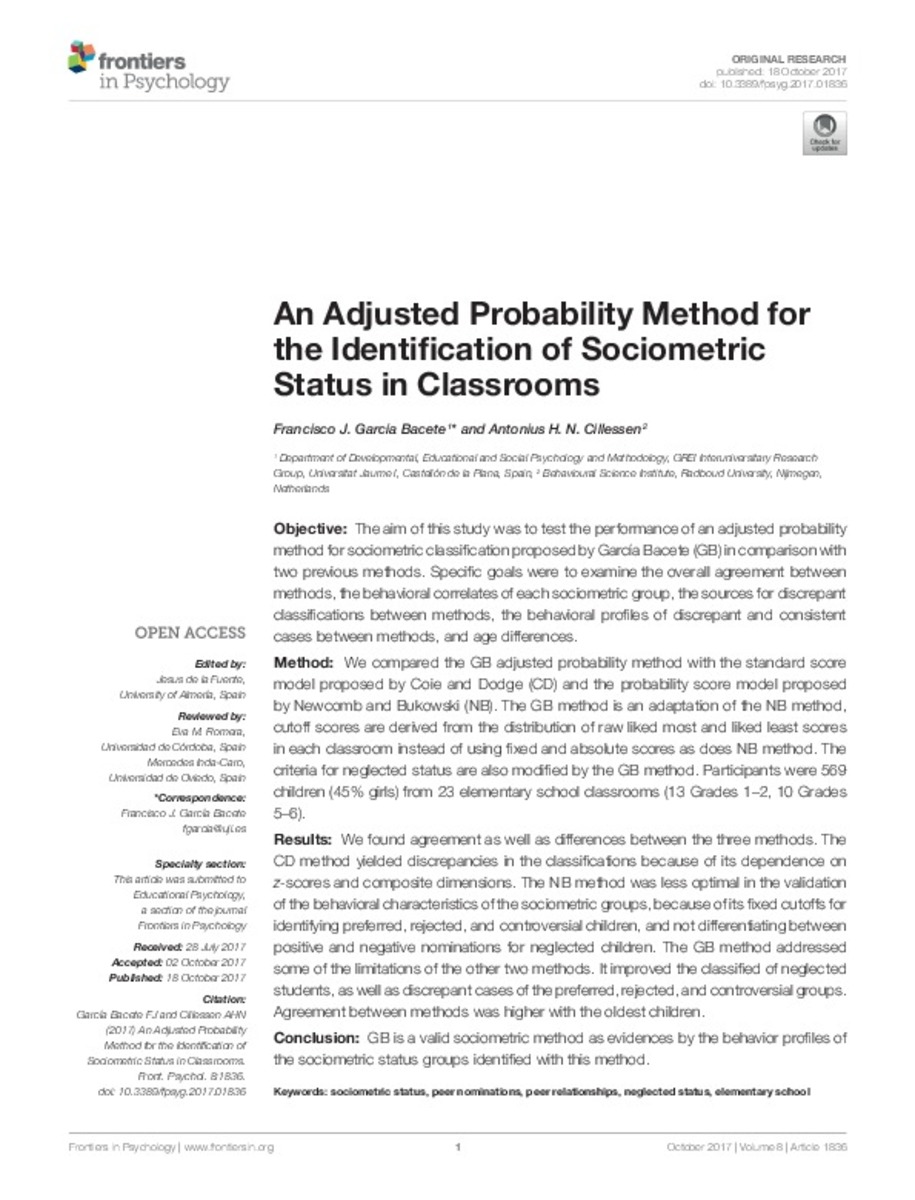Mostrar el registro sencillo del ítem
An Adjusted Probability Method for the Identification of Sociometric Status in Classrooms
| dc.contributor.author | García Bacete, Francisco Juan | |
| dc.contributor.author | Cillessen, Antonius H. N. | |
| dc.date.accessioned | 2017-10-27T06:53:07Z | |
| dc.date.available | 2017-10-27T06:53:07Z | |
| dc.date.issued | 2017-10-18 | |
| dc.identifier.citation | GARCÍA BACETE, Francisco José; CILLESSEN, Antonius H. N. An Adjusted Probability Method for the Identification of Sociometric Status in Classrooms. Frontiers in Psychology (2017), v. 8 | ca_CA |
| dc.identifier.uri | http://hdl.handle.net/10234/169633 | |
| dc.description.abstract | Objective: The aim of this study was to test the performance of an adjusted probability method for sociometric classification proposed by García Bacete (GB) in comparison with two previous methods. Specific goals were to examine the overall agreement between methods, the behavioral correlates of each sociometric group, the sources for discrepant classifications between methods, the behavioral profiles of discrepant and consistent cases between methods, and age differences. Method: We compared the GB adjusted probability method with the standard score model proposed by Coie and Dodge (CD) and the probability score model proposed by Newcomb and Bukowski (NB). The GB method is an adaptation of the NB method, cutoff scores are derived from the distribution of raw liked most and liked least scores in each classroom instead of using fixed and absolute scores as does NB method. The criteria for neglected status are also modified by the GB method. Participants were 569 children (45% girls) from 23 elementary school classrooms (13 Grades 1–2, 10 Grades 5–6). Results: We found agreement as well as differences between the three methods. The CD method yielded discrepancies in the classifications because of its dependence on z-scores and composite dimensions. The NB method was less optimal in the validation of the behavioral characteristics of the sociometric groups, because of its fixed cutoffs for identifying preferred, rejected, and controversial children, and not differentiating between positive and negative nominations for neglected children. The GB method addressed some of the limitations of the other two methods. It improved the classified of neglected students, as well as discrepant cases of the preferred, rejected, and controversial groups. Agreement between methods was higher with the oldest children. Conclusion: GB is a valid sociometric method as evidences by the behavior profiles of the sociometric status groups identified with this method. | ca_CA |
| dc.format.extent | 12 p. | ca_CA |
| dc.format.mimetype | application/pdf | ca_CA |
| dc.language.iso | eng | ca_CA |
| dc.publisher | Frontiers Media | ca_CA |
| dc.relation.isPartOf | Frontiers in Psychology (2017), v. 8 | ca_CA |
| dc.rights | Atribución 4.0 Internacional | * |
| dc.rights.uri | http://creativecommons.org/licenses/by-sa/4.0/ | * |
| dc.subject | Sociometric status | ca_CA |
| dc.subject | Peer nominations | ca_CA |
| dc.subject | Peer relationships | ca_CA |
| dc.subject | Neglected status | ca_CA |
| dc.subject | Elementary school | ca_CA |
| dc.title | An Adjusted Probability Method for the Identification of Sociometric Status in Classrooms | ca_CA |
| dc.type | info:eu-repo/semantics/article | ca_CA |
| dc.identifier.doi | http://dx.doi.org/10.3389/fpsyg.2017.01836 | |
| dc.relation.projectID | 1) Grant EDU2012-35930 from the Spanish Ministry of Economy and Competitiveness and 2) Grant P1-1A2012-04 from the Universitat Jaume I | ca_CA |
| dc.rights.accessRights | info:eu-repo/semantics/openAccess | ca_CA |
| dc.relation.publisherVersion | https://www.frontiersin.org/articles/10.3389/fpsyg.2017.01836/full | ca_CA |
| dc.type.version | info:eu-repo/semantics/publishedVersion | ca_CA |
Ficheros en el ítem
Este ítem aparece en la(s) siguiente(s) colección(ones)
-
PSI_Articles [593]
Articles de publicacions periòdiques








